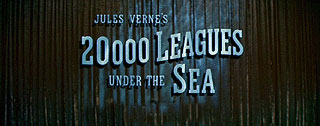
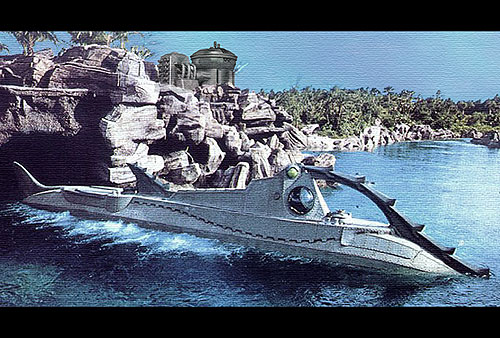
Based on the Jules Verne novel, the 1954 film, 20,000 Leagues under the Sea is set in 1850 and follows the investigation of Professor Pierre Arronax (Paul Lukas) and his assistant, Conseil (Peter Lorre) who are in search of a sea monster that has been blamed for the loss of several ships. When their own ship is attacked by “the monster”, only this pair and a harpooner, Ned Land (Kirk Douglas) survive. They escape in a small boat and drift.
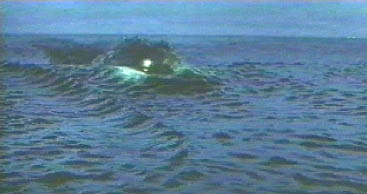
Later, while easing through fog, they encounter “the monster”, which they learn is a steel submarine called the Nautilus. The survivors are quickly captured and imprisoned on the ship by its commander, Captain Nemo (James Mason). They learn that Nemo is an advanced mind, hateful of all warfare which he seeks to eliminate by destroying the implements of war. He built the Nautilus to interdict military shipping and plans to further the cause through some other, unspecified action.
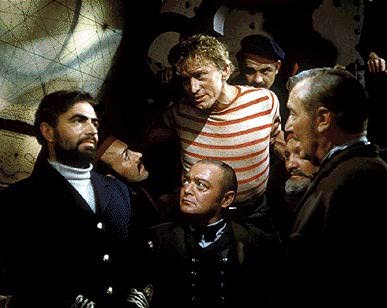
Ned and Nemo are constantly at odds with each other. During this time, Nemo shows incredible tolerance with his prisoner. His tolerance soon pays off. During a storm, while the submarine cruises safely below the surface, a giant squid latches onto the vessel, forcing it to surface. The crew emerge with harpoons and do battle with the monster in what is truly one of the most memorable scenes in all film history. Nemo is almost killed when the squid snatches him in its tentacle and drags him under the water but is saved by Ned who dives in and cuts the captain free.
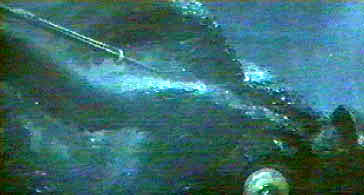
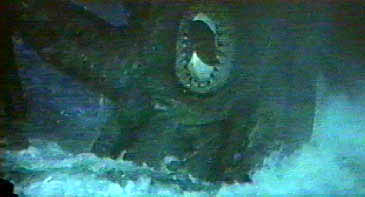
In the end, Captain Nemo is tracked to his island stronghold, a fortress of advanced technology. British warships move to take the island but Nemo, rushing moments before the troops seize his compound, sets the power generators to overload. His masterpiece of technology, along with all of his scientific advances, erupt in a huge blast. While running back to the Nautilus, Nemo is shot. Badly wounded, he staggers onto the submarine which slips away. Much to the horror of the survivors, Nemo has ordered the Nautilus to lock itself into a terminal dive. As Nemo dies, the submarine dies around him. His loyal crew intends to share is fate.
Yet, Ned isn’t ready to just accept death so easily. He manages to get the submarine back to the surface and the three of them, along with a pet seal Ned adopted, burst onto the Nautilus’ longboat and escape to the British fleet. As they depart, the Nautilus slips under the waters behind him, lost for all time …
… or so it seems.
In its 1961 sequel, “Mysterious Island”, we learn that Nemo survived the wound and is still alive. Set in 1865 just at the close of the American civil war, the tale begins with a group of escapees from a military prison camp led by Capt. Cyrus Harding (Michael Craig). They escape in an observation balloon only to be blown far out to sea. As the balloon fails them, they are dropped onto an uncharted island far out to sea inhabited by giant-sized creatures. Their rescue soon proves to be a fight for survival.
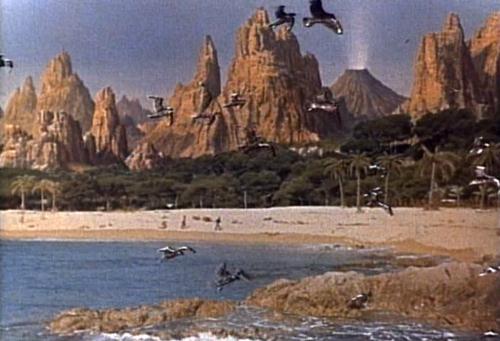
Later, a passing ship is attacked by pirates and wrecked. Two women, Lady Mary Fairchild (Joan Greenwood) and her niece, Elena (Beth Rogan) are washed ashore. With the new additions, the group soon creates a home in a cave and begins to build a new life which is briefly interrupted with the return of the pirates who pelt the island with cannon fire until their ship suddenly jolts and then sinks. After that, life returns to normal on the island and they build a small community until they make two important discoveries.
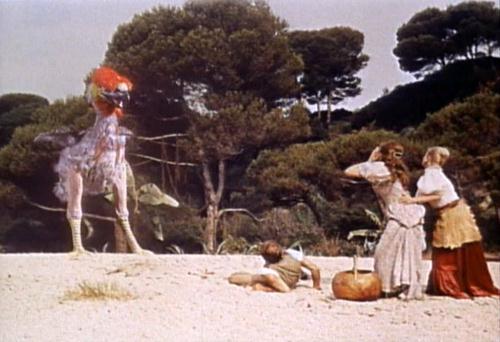
First, the island is increasing in volcanic activity and might not survive. Second, Captain Nemo (Herbert Lom) and his missing submarine are hiding in a sea cavern on the island. Nemo explains to the group that he once waged his own private campaign against the instruments of war but realized that his real target should have been the causes of war. To that end, he set his mind to fixing the basic problem of starvation. He learned to breed giant-sized animals from ordinary creatures. In this way, the food supply of the world could be multiplied and the reasons for conflict reduced. Yet he can’t take this discovery away as the Nautilus has been damaged and can’t survive a voyage far away from the island. Nemo also confirms that the island will soon destroy itself.
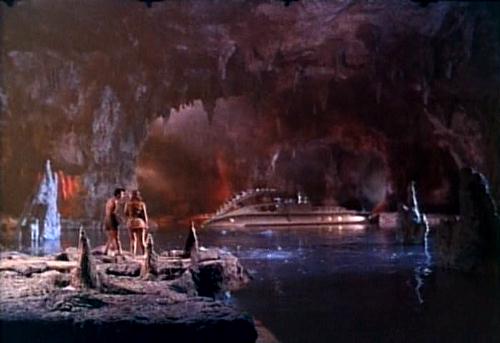
Faced with this danger, they come up with a brave plan to escape. Using equipment from the Nautilus, they will raise the sunken pirate ship by inflating the hot air balloon inside its hull, forcing the ship to the surface. They race to complete the underwater task, passing ancient ruins from some lost civilization, while above them, the volcano starts to spew fire and ash.
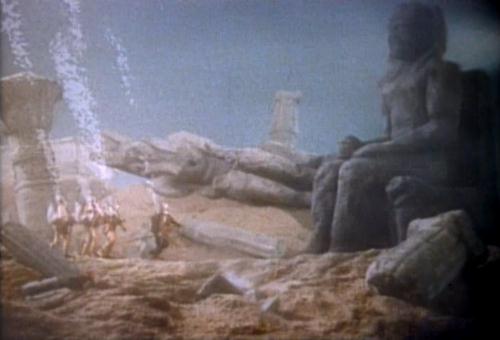
The plan succeeds and the ship rises to the surface. Before he can gather his research and join them, Nemo is trapped as the sea cavern collapses, entombing the submarine.
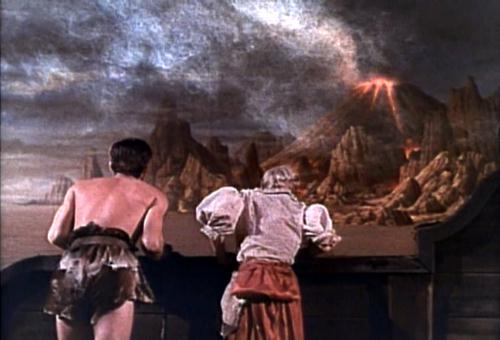
Sorrowful, the survivors sail away from the island as it becomes a mass of molten lava.
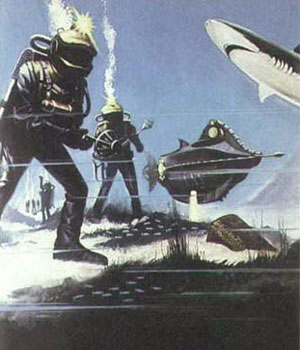
COMMENT:
Both 20,000 Leagues Under the Sea and Mysterious Island are good adventure stories that do a good job of preserving the magic of Jules Verne’s writing.
James Mason is masterful as Captain Nemo and brings dignity to the role that surpasses the book. Kirk Douglas’s performance is a bit too campy and his interactions with the pet seal are a bit too fluffy for most viewers. Likewise, his song singing in the beginning of the film, mixed with his smiling and energetic portrayal of Ned, differ wildly from the hardened seaman of Jules Verne’s novel.

The Nautilus is superb and a great gift by art director John Meehan. Its exterior is a steel monstrous beast, with two great eyes that shine menacingly as the submarine lances through the water. Underwater, it glides gracefully through the scenery like an noble fish. The interiors are well designed, providing the perfect period feel even through the advanced technology that allows it to be the superweapon against war. Concurrently, the brief glimpses of Nemo’s island fit perfectly, hinting at advanced knowledge based on 1800s gadgets. You feel a real sense of loss when it is blown apart at the end of the film.
Mysterious Island continues the story in a way that is completely different than the first tale but still seems to fit. They are very different stories with very different styles. Ray Harryhausen’s animations with the giant beasts are an absolute joy to watch. The movie is an adventure story but these creatures are the real stars. Captain Nemo is merely the linking pin between 20,000 Leagues under the Sea and this tale.
Both films engage in some rather silly commentaries about the evils of war.
They are simplistic in their approach to the causes of warfare and consequently waste the time explaining the background of Nemo’s passion.
Mysterious Island is the larger violator in this arena, employing newspaper reporter Gideon Spilitt (Gary Merrill) to present Nemo’s case and explain that he’s not a madman who sent hundreds to their deaths at sea, but a visionary seeking peace for all mankind. You don’t buy the explanation whatsoever but it does provide the needed backdrop for Nemo’s exploits on the island.
The other significant difference is the inclusion of the love story between Elena and Herbert Brown (Michael Callan) in Mysterious Island. This is handled well and proves critical to establish the feel of a new colony suddenly threatened by the eruption of the volcano.
– written by the Two-Brained Cylon